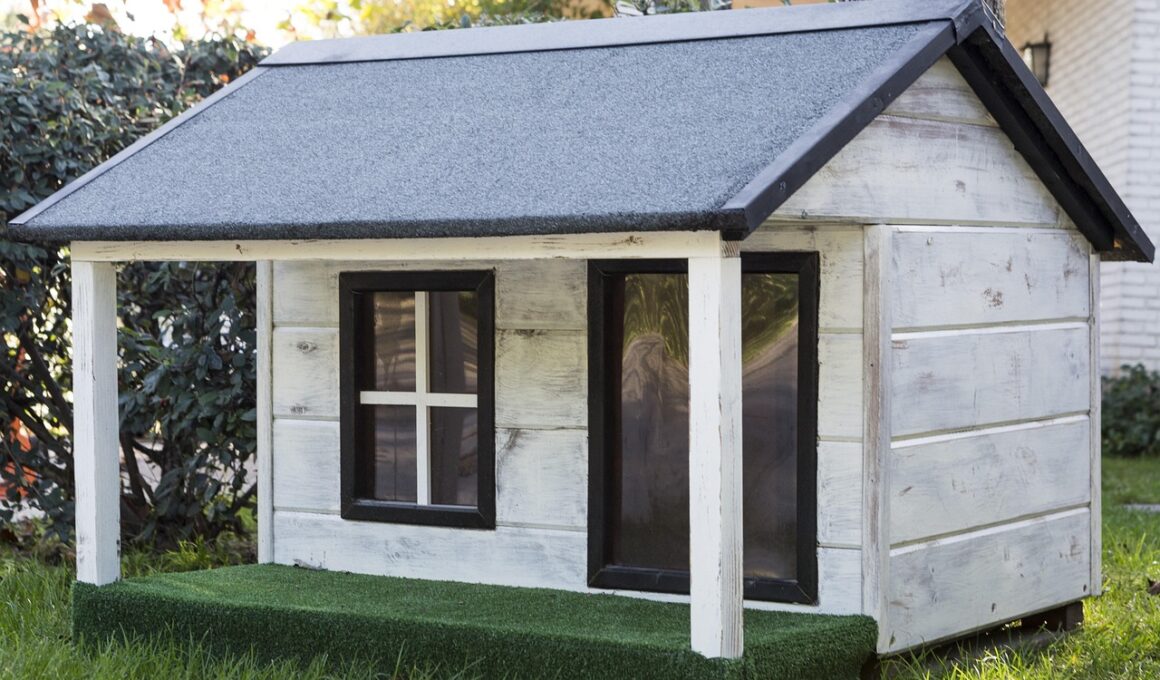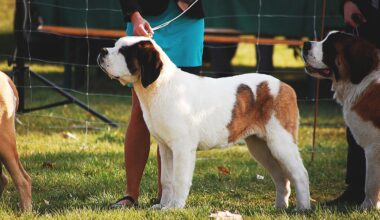Cost-Effective Tips for Building a Large Dog House
Building a large dog house can be a rewarding project, providing a safe and cozy space for your furry friend. Start with effective planning to save money and time. First, measure your dog’s size to ensure the house you build can comfortably accommodate them. Take the height, length, and width into consideration. Choose materials wisely; while you want durable materials, costs can escalate quickly. Look for reclaimed wood or plywood, as they are often more affordable and sturdy. Don’t forget about ventilation; a well-ventilated house will keep your dog comfortable during different weather conditions. It’s crucial to elevate the house off the ground to prevent moisture problems. Research dog house designs for ideas that suit your dog’s needs while staying within budget. The internet has many free designs and resources for DIY projects. Depending on your dog’s size, add insulation using Styrofoam panels for heating in winter. Finally, remember to check local building codes to ensure your house meets regulations. DIYing your dog house not only saves money but provides a personal touch, making your project unique. Go ahead and start planning today!
Next, gather tools that you’ll need for building the dog house. Standard tools like a saw, hammer, nails, and a measuring tape should be considered essential. Having the right equipment can make a significant difference in your building experience and the quality of the finished product. You might also want to think about having some extra woodworking tools such as a drill and level to ensure everything is aligned perfectly. Safety should always come first; wear protective eyewear and gloves while working on your project. Before cutting any materials, double-check your measurements to avoid waste and unexpected costs. As you start building the walls, it’s important to assemble them in such a way that they provide high durability against wind and rain. Reinforce the corners with additional supports when needed to increase stability. After constructing the base, ensure that the foundation is level, as this is crucial for maintaining the integrity of the dog house. Once the base and walls are secure, work on the roof design. A sloped roof can help with rainfall drainage, and you might opt for shingles to match your home’s aesthetic. Finalize your build by adding a dog door that suits your dog’s size.
Finishing Touches for Your Dog House
Once the structural elements are complete, it’s time to focus on aesthetic and practical finishing touches for your dog house. Painting is an excellent way to protect the wood from the elements while allowing for customization. Use non-toxic, pet-safe paint or stain to ensure your dog is safe even when chewing the wood. You can pick bright, fun colors to enhance your yard or choose neutral tones to blend seamlessly into your landscape. Additionally, consider adding a roof overhang to provide extra shade and protection from rain. Remember to create a sturdy, comfortably sized entrance, allowing easy access for your dog. It’s also a good idea to line the base with straw, blankets, or a pet bed to keep your dog warm and cozy. Further, you can add toys or a small shelf for their chew items or food bowls. Create an inviting exterior by planting flowers or shrubs around the dog house, making it a pleasant feature of your yard. This kind of project allows you to combine functionality and artistic expression, resulting in a beautiful and comfortable retreat for your beloved pet. Your dog will appreciate it!
To keep the dog house in good condition, regular maintenance is essential. Inspect the structure every few months to identify any signs of wear or damage. Look for loose nails, cracks in the wood, or areas where moisture could enter. Address any issues promptly to maintain a safe haven for your dog. You might also need to touch up paint or stain worn areas to prevent wood rot caused by exposure to moisture. In addition, keep the inside clean by regularly removing any debris, dirt, or old bedding. This ensures a healthy environment for your pet. It’s ideal practice to reapply non-toxic sprays or sealants annually to continue protecting the wood. During winter months, ensure that your dog house is adequately insulated; consider adding blankets or specialized pet beds for warmth. If you live in an area prone to extreme weather, provide additional shelter during storms. Installing awnings or tarps can add another layer of protection. By keeping your dog house maintained, you’re not only ensuring comfort but also significantly extending its lifespan, ultimately saving you costs in the long run.
Benefits of a DIY Dog House
Building a DIY dog house holds several advantages, making it an appealing project for many pet owners. The most obvious benefit is cost savings. Compared to purchasing a pre-fabricated dog house, creating your own can save a significant amount of money, especially if you utilize recycled materials. Another key advantage is personalization; you can custom-tailor the house for your dog’s specific needs, whether that involves adjusting size or adding particular features. Additionally, you can choose sustainable materials that resonate with your values while offering durability. Moreover, the satisfaction gained from a hands-on project is invaluable, enhancing the emotional bond you share with your pet. Completing the dog house serves as a testament to your commitment to providing a loving environment. Further, a well-constructed dog house can contribute positively to your yard’s aesthetics. A DIY dog house can become a remarkable addition to your landscaping, showcasing your creativity and craftsmanship. Plus, engaging in the building process allows you to share quality time with family or friends, making it a fun, collaborative experience that provides lasting memories!
As seen, there are numerous aspects to consider when building a large dog house. It’s essential to prioritize the needs of your dog while also factoring in your personal style, budget, and available resources. One important element involves researching different designs to inform your construction choices. Websites, blogs, and forums dedicated to pet care often offer helpful insights, sharing experiences and tips that can guide your planning. Another point to consider is climate; different weather conditions can impact your dog house’s design and insulation methods used. For instance, dogs living in warmer climates might require better ventilation, while those in cold regions need extra insulation. Always keep your dog’s size, breed, and temperament in mind when designing and building the house. For added peace of mind, consult professionals or experienced builders if you have any doubts about construction techniques. Whether you go for something simpler or a more elaborate design, the key is to create a space where your dog feels safe, comfortable, and happy. Consider these tips to ensure a successful DIY project that you and your pet will cherish for years.
Conclusion and Final Thoughts
In conclusion, building a large dog house can be a fun and rewarding experience that provides extensive benefits for your pet. By following the tips outlined in this article, you can create a comfortable, safe haven that meets your dog’s specific needs while being cost-effective. Remember to prioritize durability and functionality during construction, selecting suitable materials and ensuring proper insulation and ventilation. Personal touches, such as colors and design, can also transform your dog’s house into a delightful addition to your yard. Don’t forget the importance of regular maintenance; keeping it in top condition is vital to your pet’s long-term comfort and health. Engage with online communities for additional ideas, support, and creative solutions. This project allows you to express your creativity and strengthen your bond with your dog. So grab your tools and start building! With effort, you can design a dog house that you both will proudly enjoy for years ahead, ultimately reflecting the love and care you have for your furry friend. Your DIY project will stand as a testament to your commitment, turning into a cherished shelter for your beloved pet!


